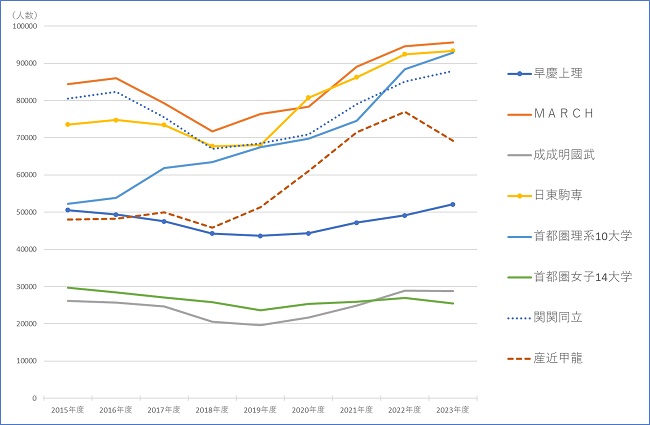There is already a lot of information circulating about the 2023 entrance exam results, and public interest is already focused on the next 2024 entrance exam.However, if you change your perspective on the 2023 entrance examination results, there is also new information that can be obtained.Looking at the graph of the number of successful applicants by university group, the difficult private universities in urban areas that are popular with examinees are drawing a gentle V-shaped curve with the bottom in 2018-2019.In other words, the number of successful applicants to difficult private universities is on the rise.

2023 entrance examination results by university group
Kawaijuku's university entrance examination information site, Kei-Net, publishes entrance examination results in multiple cross-tabulations, such as by region, department system, and major university group.Overall, the number of applicants for general selection at private universities has decreased by 96% compared to the previous year.In addition, the number of successful applicants decreased by 98% compared to the previous year.Usually, when the number of applicants decreases, the number of successful applicants also decreases almost in tandem. As the 18-year-old population is declining, the number of applicants is trending downward.As a result, the number of successful applicants is also declining.This is the most natural result.
However, when we look at the entrance examination results by university group, the situation changes slightly.Difficult and popular Waseda University (Waseda University, Keio University, Sophia University, Tokyo University of Science), March (Meiji University, Aoyama Gakuin University, Rikkyo University, Chuo University, Hosei University), Kansai University (Kansai University) , Kwansei Gakuin University, Doshisha University, and Ritsumeikan University), the year-on-year increase in the number of successful applicants exceeded 100%.Waseda University 106% (+2,988 people), MARCH 101% (+1,090 people), Sekiseki Ritsuryu 103% (+2,948 people).The number of applicants for Sekiseki University has increased by 7,000% compared to the previous year, so it is possible that the number of successful applicants will increase. is increasing.These universities are a group with a large capacity, so if the number of successful applicants increases, it will have a large impact on the securing of applicants for middle-ranking universities and below.
Furthermore, if we add 912 more successful applicants to Nitto Komasen (Nihon University, Toyo University, Komazawa University, Senshu University) to the above three groups, the total number of successful applicants will increase by about 8,000 compared to the previous year. You are doingSince the enrollment capacity of relatively small women's colleges is around 400 to 500 students, the number of successful applicants has increased to the equivalent of about 10 women's colleges.Applicants who have passed entrance exams to multiple universities are admitted in order of difficulty and popularity, so even though it is a total number, we can see how big an impact this 8,000 increase will have on the enrollment rate of each university below mid-ranking. Masu.
Kawaijuku Kei-Net "General Selection Entrance Examination Results Aggregated Data Private Universities (Overall Overview, By District, By Faculty System, By Major University Group)" (as of 23/07/07)
https://www.keinet.ne.jp/exam/past/index.html
V-shaped curve graph with 2018-2019 bottom
Looking back a little at the number of successful applicants of these difficult university groups and graphing the transition over time, we can see common characteristics.It is in the shape of a gentle V-shaped curve that bottomed out in 2018-2019 (Figure).Waseda University bottomed out in 2019, but MARCH, Sekiseki Ritsu, and Nitto Komasen are drawing a V-shaped curve that bottomed out in 2018.Sankin Koryu (Kyoto Sangyo University, Kinki University, Konan University, Ryukoku University) will also see a decrease in the number of successful applicants in 2023, but until then the number of successful applicants will increase in a V-shaped fashion.

However, the number of successful applicants is consistently increasing at the 10 science universities in the Tokyo metropolitan area.The 10 capital science universities are Chiba Institute of Technology, Kitasato University, Kogakuin University, Shibaura Institute of Technology, Tokyo University of Technology, Tokyo Denki University, Tokyo City University, Tokyo University of Agriculture, Azabu University, and Kanagawa Institute of Technology.It's an unlikely combination of engineering universities with medical and agricultural universities mixed together, but I think it's a reasonable combination when looking at the general trends of science students in the Tokyo metropolitan area.
In this group, Chiba Institute of Technology, which has been ranked second in the ranking of universities with a large number of general applicants for the past few years, is grouped, and the number of applicants is also increasing. Therefore, it is natural that the number of successful applicants will increase.In the past few years, Bunko Riko, in other words, the popularity of science, has increased the number of applicants among the 10 capital science universities, besides Chiba Institute of Technology.As mentioned above, there is a tendency similar to the law of an increase in the number of applicants and an increase in the number of successful applicants, so the graph looks like this.Again, this is likely to have a negative impact on securing the number of students enrolled at other universities below the mid-level.
Impact of “stricter capacity management” and deregulation
Why is it such a wonderful V-curve graph?It is self-evident for those involved in private universities, but by 2018, each university has reduced the number of successful applicants by correcting the excess rate of enrollment capacity, so-called "stricter quota management". It can be said that it is clearly shown in the shape of the graph.
This policy had the effect of correcting the excess rate of private universities in the three major metropolitan areas (lowering the excess rate) and filling the capacity of local private universities.The policy was successful, but it also had side effects.In order for each university to strictly manage the number of students, by announcing additional successful applicants multiple times, the financial and psychological burden of having to go through the admission procedures over and over again has arisen.Not just for students.On the university side, the burden of pass/fail judgment and clerical work due to the additional announcement of successful applicants increased, and the number of regular successful applicants was reduced in order to strictly manage the quota. , There were also universities where the so-called under-capacity situation became constant.
For this reason, since 2019, the Ministry of Education, Culture, Sports, Science and Technology has implemented measures to increase subsidies to universities that have fallen short of their quota as a result of strict management of quotas.Although it seems that the situation has improved somewhat, in the end there was no good idea other than adjusting the number of students enrolled by additional admissions, and the situation of examinees remained unstable.
Therefore, from 2023, the Ministry of Education, Culture, Sports, Science and Technology will dramatically change the system for managing the number of students.Until now, there were two standards for capacity management: the standard for the excess rate of new students enrolled in the year (enrollment capacity excess rate) and the standard for the excess rate of admission capacity for all grades (accommodation capacity excess rate). .As anyone who's ever worked with capacity management knows, this is a really good regulation system.
However, among these two criteria, the criteria for the over-enrollment capacity rate will be abolished from the 2023 academic year.Due to this deregulation, even if the number of students enrolled in one year exceeds the standard, by reducing the number of successful applicants in the following year, the excess rate of admission capacity can be adjusted to within the standard.In other words, for the university, it has become a system that can redo the capacity management over several years.
For this reason, universities that had previously kept the number of regular successful applicants low and adjusted the number of applicants with additional successful applicants are now able to boldly increase the number of regular successful applicants.From the student's point of view, the situation has improved.This time, however, the number of regular successful applicants at popular large universities has increased, making it difficult for medium-sized and smaller universities to secure enrollment.This created a situation in which the strong take all and the market leader wins alone.From the perspective of small and medium-sized universities, the situation is worsening.
It may be said that it is an unintended "fallacy of composition" in which each acted in pursuit of the best, aiming to improve the situation, resulting in unexpected adverse effects.
